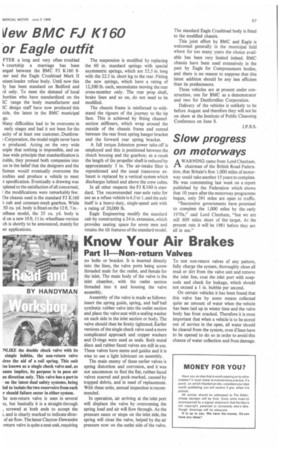Know Your Air Brakes
Page 59

If you've noticed an error in this article please click here to report it so we can fix it.
Part II—Non-return Valves
NLIKE the double check valve with its simple bobbin, the non-return valve tires the aid of a coil spring. This unit lso known as a single check valve and, as name implies, its purpose is to pass air tie direction only. This valve has a part to on the latest dual safety systems, being led to isolate the two reservoirs from each T should failure occur in either system. be non-return valve is seen in several is, but basically it is a straight-through , screwed at both ends to accept the ;, and is clearly marked to indicate direcof air flow. The latest ClaytonDewandre -return valve is quite a neat unit, requiring
no bolts or bracket. It is inserted directly into the lines, the valve ports being screw threaded male for the outlet, and female for the inlet. The main body of the valve is the inlet chamber, with the outlet section threaded into it and housing the valve assembly.
Assembly of the valve is made as follows: insert the spring guide, spring, and half ball synthetic rubber valve into the outlet section and place the valve seat with a sealing washer on each side in the inlet section or body. The valve should then be firmly tightened. Earlier versions of the single check valve used a more complicated approach and copper washers and 0-rings were used as seals. Both metal discs and rubber-faced valves are still in use. These valves have stems and guides and it is wise to use a light lubricant on assembly.
The main enemy of these earlier valves is spring distortion and corrosion, and it was not uncommon to find the flat, rubber-faced valves scarred and pock-marked, caused by trapped debris, and in need of replacement. With these units, annual inspection is recommended.
In operation, air arriving at the inlet port will displace the valve by overcoming the spring load and air will flow through. As the pressure eases or stops on the inlet side, the spring will close the valve, helped by the air pressure now on the outlet side of the valve. To test non-return valves of any pattern, fully charge the system, thoroughly clean all mud or dirt from the valve unit and remove the inlet line, coat the inlet port with soapsuds and check for leakage, which should not exceed a 1 in. bubble per second.
On certain vehicles it has been found that this valve has by some means collected quite an amount of water when the vehicle has been laid up in winter time and the valve body has frost cracked. Therefore it is most important that when a vehicle is to be stored out of service in the open, all water should be cleared from the system, even if lines have to be opened to do so in order to avoid this chance of water collection and frost damage.








































































































































































